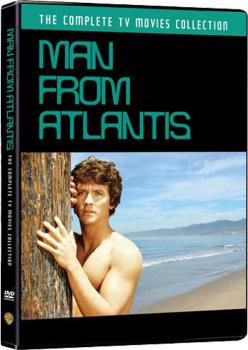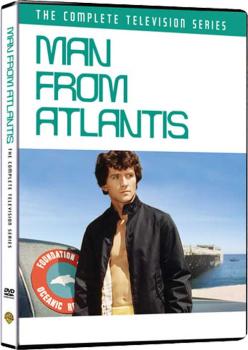
Hey, M.O.D. fans. Let's ask you something: in your DVD library, do you keep your M.O.D.s separate from your "store bought" discs?
We knew it.
You don't let them rub shoulders alphabetically or Dewey Decimal System-style with your Wal-Mart® bargain bin castoffs, do you. You have a special shelf for your M.O.D.s, don't you. Right over the mantle. With a baby spot on them. And when your neighbor stops by and stands transfixed in front of them, you saunter over―a little smugly, we allow―putting a firm but gentle hand on his shoulder while calmly saying, "These...are not for you. These are special. You can't just buy them anywhere." Don't you. And as you lead him away as he struggles to grab one last look over his shoulder at the entire series of Man from Atlantis or Budd Boetticher's The Rise and Fall of Legs Diamond, that's when you know...when you know, that it's you who are special. You, you M.O.D. collector. You, you M.O.D. lover.
You feel good about yourself knowing that, don't you?
For this latest edition of DVDTalk's The M.O.D. Squad, we've got a whole slew of new M.O.D. reviews, with the emphasis definitely on action and suspense (can you tell it's mainly dudes here at DVDTalk?) as we get ready to tell this summer to, "kiss off!" As well, announcements about upcoming M.O.D. releases, reviews, and sales, along with a new feature―our M.O.D. Squad Spotlight, where we take a closer look at a special M.O.D. release―are all here for you, too, M.O.D. maven. So let's get to it!
Man from Atlantis
Our new M.O.D. Squad Spotlight section features DVDTalk editor John Sinnott's full review of Man from Atlantis: The Complete Television Series, the NBC sci-fi cult favorite from 1977, starring Bobby Ewing Patrick Duffy that spanned four made-for-TV movies and an aborted-run 13-episode first (and last) season. The Man from Atlantis movies and regular series episodes are exactly the kind of programs perfectly suited to a M.O.D. service like the W.B.'s Archive Collection: a well-remembered fan favorite...with iffy prospects of a wide disc printing and release. John Sinnott had a lot of fun revisiting this series; here's his review:
Man from Atlantis
reviews by John Sinnott
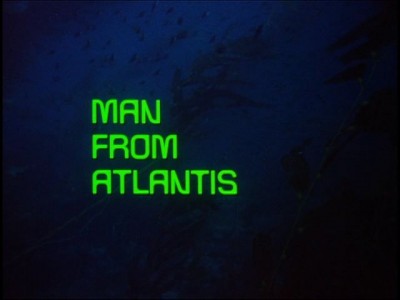
Back in the summer of 1977 if you went to the public pool
that I frequented, you'd see a lot of young boys (especially yours
truly)
diving underwater and moving around like they were having an epileptic
seizure. We weren't having fits, we were
trying to swim link Mark Harris, the Man from Atlantis.
The series started off with not one, not two,
but four made-for-TV movies that were rated highly enough to earn the
concept a
weekly TV series. After that lengthy
trial, you'd assume that the show would get solid ratings.
That wasn't the case. A lower
budget, silly scripts and a villain
who was featured way to often doomed the show to only 13 episodes.
Still fondly remembered (and featuring
Man from Atlantis (aired 3/4/1977): After a violent storm at sea a man (Patrick Duffy) washes up on shore, unconscious. When discovered, he's whisked to a hospital where they have trouble reviving him. He's on pure oxygen, but he is still having trouble breathing. He's turning blue and the doctor's are surprised at his webbed fingers. They call in a specialist who happens to be attending a party with a female oceanographer in the Navy, Dr. Elizabeth Merrill (Belinda Montgomery).
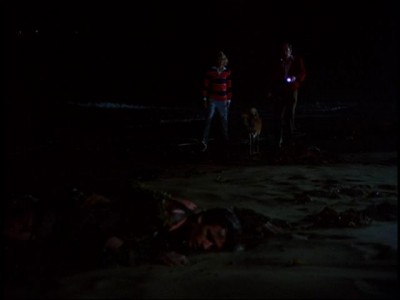
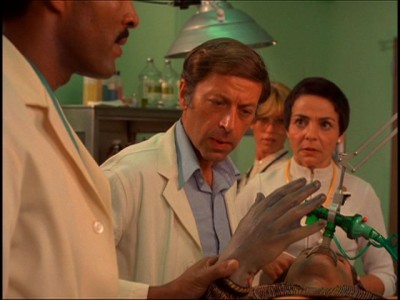
The doctor is just as perplexed as everyone else, but Dr. Merrill has a strange theory. After taking a look at his lungs, she convinces the hospital to take the man back to the ocean. There she pushes him under the water and he revives.
Taking him back to a Navy base,
Dr. Merrill's commander wants to use the man, given the name Mark Harris, as a military asset, while
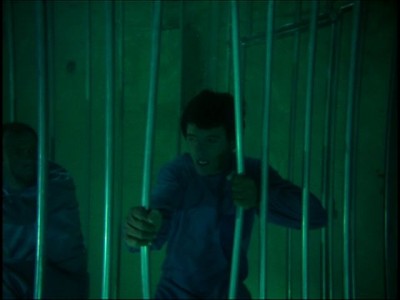
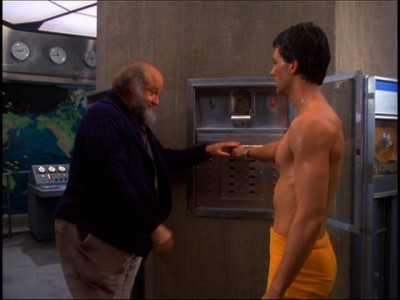
They take him to a deep part of the ocean and Mark dives down to search for the missing research vessel. What he discovers is an undersea lab. It's run by Mr. Schubert (Victor Buono) who tricks some of the world's top scientists to come and work for him. Once they've arrived the scientists are given bracelets that brainwash them into being docile workers. Schubert's plan, and it's almost complete, is to hack into every nuclear missile system in the world simultaneously and have the rockets launch. This will eradicate the humans on land, who have shown that they are capable of taking care of the planet, and leave Schubert and his scientists to create a utopia under the sea. Luckily the bracelets don't work on Mark, but how can one man stop this entire mad operation.
This is a fun, light, 70's SF TV movie. It's not ground breaking in the plot or SF elements, but it's enjoyable none the less. While Mark doesn't have much of a personality in this first outing, it's fun to watch him wiggle his way through the water in his unique swimming style. A lot of the appeal of the show is that the viewers know Mark is special, but other people don't. When he takes off his scuba gear before diving to search for the missing sub, everyone knows the diver with him will freak out, and it's fun when he does. Likewise when Shubert tries to kill Mark by locking him into a metal cage and lowering him under the water, viewers know it'll never work, and that's the fun of the film.
The Death Scouts (aired 4/22/1977): As this movie opens Dr. Elizabeth Merrill has left the Navy and taken Mark with her. She's now a part of The Foundation for Ocean Research (FOR), along with fellow scientist Dr. Miller Simon (Kenneth Tigar) and chief administrator C.W. Crawford (Alan Fudge). The foundation has a sub (that is identical to Mr. Shubert's. I guess it was given to the FOR by the Navy, which was nice of them) the Cetacean, with which they conduct their research.
This adventure begins when three boaters and pulled into the water by some mysterious entity. The water around their boat is acidic and the Coast Guard has no idea what happened. They call in the FOR who gladly investigates. At the scene Mark finds a trail of strange rocks. Eventually he follows them and they lead to a space ship. Inside is the same logo that Mark has on his swim trunks, the only clue he has as to where he comes from. Could he be an extraterrestrial?
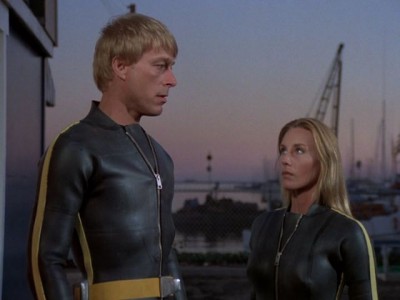
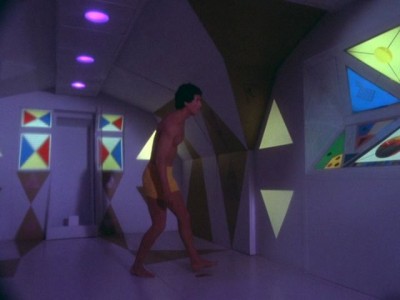
Meanwhile one of the boaters washes up on shore, dead as a doornail but the other two walk out of the surf with webbed hands, just like Mark. Everything is foreign to them and when they get nervous, the pair join hands and are able to generate an electrical shock which can knock anyone on their butts. Mark encounters them in the town and is sure they know where he comes from, but they shock him and run off. Are they friendly, confused aliens or an advance invasion force?
Like the first movie, this one has a lot of 70's charm. No, it's not great and some of the explanations will cause viewers to roll their eyes, but hey, it's still a lot of fun. The SF aspects come to the forefront in this story and they work even though the budget is really low. The spaceship is basically one small room with color plastic shapes on the walls and the alien's only visible weapon is baby powder but it's still has a sense of safe family fun.
The Killer Spores (aired 5/17/1977): This is my favorite of the TV movies. When a NASA space probe is returning to Earth, it passes through a strange cloud that changes its trajectory. The probe lands in the ocean and the FOR is asked to retrieve it. The Cetacean heads out.
When they find it, Mark goes out and brings the probe back, but when he returns he's acting strangely. He will start to describe some odd things he saw on the exterior of the probe, but then stops in midsentence and not only forgets what these things looked like, but that he ever saw them at all.
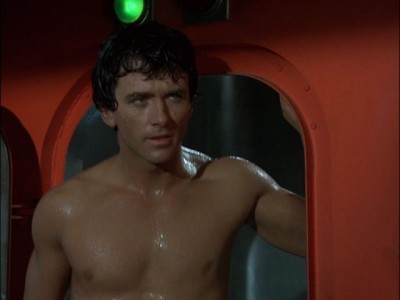
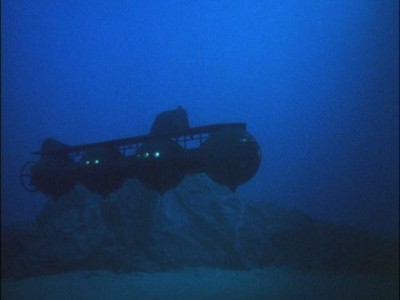
It turns out that the probe brought back an alien form of life that's invisible to the human eye. These spores are not only hard to detect, but they can take over people's minds and make they do anything that they want. At first Miller and Elizabeth are skeptical, but when they're convinced that the spores exists, they want to find a way to kill them. Mark, who can communicate with the spores, wants to talk with them. But when they start making people in town run amuck, it looks like there isn't much that anyone can do to stop them.
The spores were an interesting concept, but my favorite part of this show was that the FOR wouldn't give back the space probe after they discovered it was infected. It's not played for laughs but I get a kick out of the scenes where someone will have to explain to NASA that they're not quite ready to give them their multi-million dollar probe back. I can always imagine the guy at the other end of the line freaking out when CW says he'll check on it and get back to him.
I also enjoyed the scenes where people were possessed by the spores, especially when the FOR secretary are on the phone to NASA laughing and making sexual innuendoes. I remembered that from when I originally saw the movie, back in '77.
The Disappearances (aired 6/12/1977): This is the fourth movie in the series to air in a little over three months. That's a pretty tight schedule so it's no surprise that they cut a few corners on this one. The plot is almost identical to the first movie.
When a rich man expresses an interest in donating a large ship to the FOR, everyone is excited. The man asks Dr. Merrill to inspect the ship, but when she shows up she's kidnapped and taken to a remote island. There we meet Dr. Mary Smith (Darleen Carr... I guess they even had trouble coming up with a name for the villain) a brilliant but disturbed scientist. She's decided that the human race is doomed, and is working on a plan to save herself and a selected number of her followers who will start a utopian society. They need
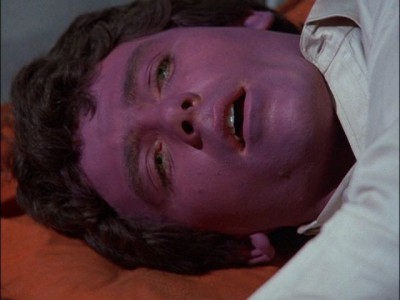
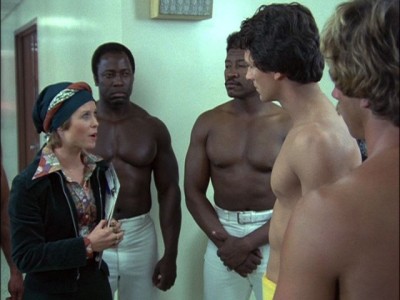
Meanwhile at the FOR, Mark and Dr. Simon are visited by the FBI who inform them that the guy who kidnapped Dr. Merrill is linked to over a dozen kidnappings of scientists, maybe even more. He leaves a copy of his files, which Mark and Miller got through with a fine toothed comb. Needless to say, the pair figure out just where
Mark and Miller try to sneak into the base, but are captured, brought to Dr. Smith and then dunked into the spa. Miller is instantly euphoric, but Mark, surprise, surprise, is immune to the effects of the water. But can one fish-man take on a base filled with shirtless guards and discover just what Dr. Smith's plan is?
This story was way too close to the first movie's plot. It even ends with a similar speech about the Earth being doomed because of wasteful humans. I remember being disappointed for that reason when it first aired. Not only that, but some of the incidental touches came across as irritating. All of the guards on the base (why do you need guards if everyone is docile?) are all muscle builders who go around shirtless. It came across are really silly... this is supposed to be a scientific research center after all. I guess if I was a mad scientist with a secret base I'd fill it with topless Victoria Secret models, so I can't complain too much.
All in all these four movies were a lot of fun and I was terribly excited back in '77 when it was announced that Man from Atlantis would be a weekly series. That joy was short lived.
After four (!) made for TV movies which aired from early March through mid-June in 1977, Man from Atlantis was granted a weekly series. It seems that the network was being really careful with the show. Making a concept prove itself with basically four pilots is pretty unusual. In any case the telefilms garnered sufficient ratings and in September of 1977 Man from Atlantis returned to the small screen as a weekly series. Thirteen installments later it was gone for good. With only 13 episodes the show didn't make it into syndication and it has rarely been seen since its original run. Now Warner Archives has release the entire series (along with the four made-for-TV-movie in a separate set reviewed here) in a nice four disc set.
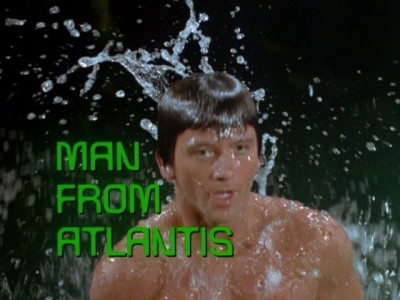
As related in the first movie, Man from Atlantis, a man (Patrick Duffy) washes up on shore unconscious after a violent storm at sea. When discovered, he's whisked to a hospital where they have trouble reviving him. He's on pure oxygen, but he is still having trouble breathing. He's turning blue and the doctor's are surprised at his webbed fingers. Oceanographer Dr. Elizabeth Merrill (Belinda Montgomery) stumbles onto the patient and after examining him convinces the hospital to take the man back to the ocean. There she pushes him under the water and he revives.
The man, who is given the name Mark Harris, has amnesia and has no idea where he's from, so Dr. Merril puts his through a series of tests. He can live in water with no ill effects, and starts to get weak if he's out of the element for more than four hours. He's sensitive to the light, his eyes more adjusted to seeing in the murky depths, and he can stand the pressures of the deep ocean. All of this data is plugged into a supercomputer which spits out the surprising answer: "THE LAST CITIZEN OF ATLANTIS ???"
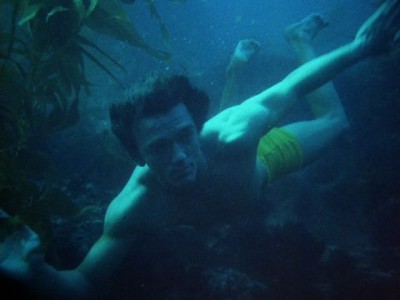
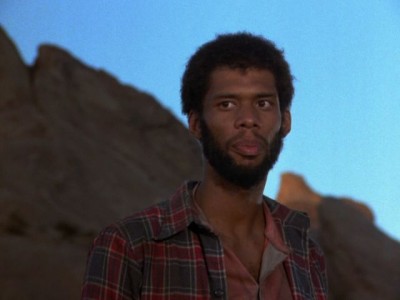
Dr. Merril works for The Foundation for Ocean Research (FOR), along with and chief administrator C.W. Crawford (Alan Fudge). (Her partner from the movies, Dr. Miller Simon, is gone without an explanation.) The foundation has a sub the Cetacean, with which they conduct their research. Along with Mark, Elizabeth and the crew of the Cetacean protect mankind from dangers originating in the seas, and the frequent villain the rich and diabolical Mr. Schubert (Victor Buono).
Over the short run of the series, Mark encounters a variety of nefarious menaces. The world's oceans start to rise when Schubert starts melting the ice in the arctic, a giant Portuguese Man O' War plagues a swim meet, and C. W. drinks a vial of enzyme from a sea creature that causes Jekyll and Hyde-like personality changes. All of these are fairly standard fare for a SF show from that era.
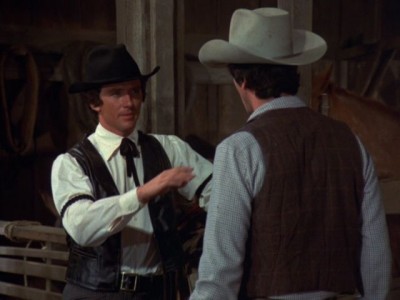
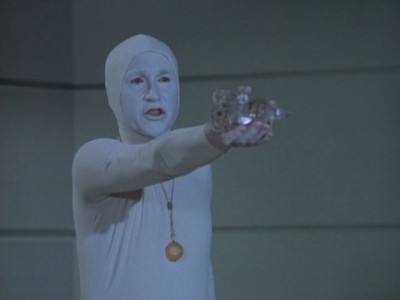
There are a couple of problems though. First, the show pitted Mr. Schubert against the FOR way too often (in 5 of the 13 episodes.) Victor Buono (who played King Tut in the Batman TV show) chews the scenery overacts in every scene he's in. His character doesn't make much sense, a very, very rich man who desperately wants Mark so that he can run tests on him (for undetermined reasons.) Yet he blackmails the world on several occasions but the police and military never go after him or even seize his assets. In his best Dr. Evil impersonation he creates needlessly complex plans to either capture Mark or control the world.
While the show is not camp, it does get rather silly. I have to admit I loved the sillier episodes both when it originally aired and while rewatching the series, but I can see how a lot of viewers would roll their eyes at some of the villains. There is a two-headed sea monster that's controlled by a con man, an Imp named Moby who causes people to behave like children when he touches them, and Mark gets transported back in time not once, but twice! (The first time to the old west, and the second to 14th Century Italy where he gets thrown into the middle of Romeo and Juliet.) That's not to mention the time Mark discovers a crack in the ocean floor that is causing the world's water to drain away. Yeah, right.
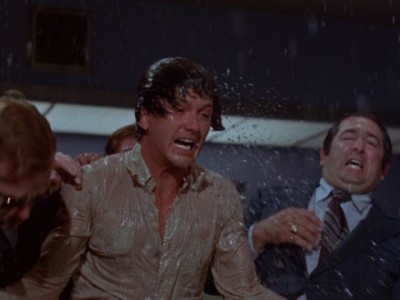
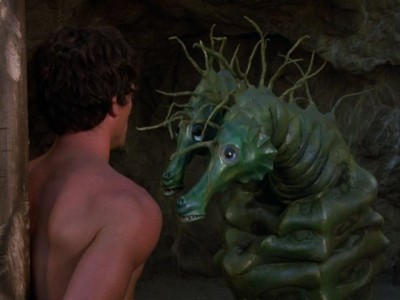
Like I said, I enjoyed these shows, but I'll be the first to admit that the production values took a slight step down when it went to a weekly series and scripts got significantly weaker. Still there were a lot of fun stories, like the one that had Kareem Abdul-Jabbar as a gold-mining giant in another dimension. But for every fun, goofy story there's at least one goofy story that's just stupid, such as Crystal Water, Sudden Death where Mark encounters powerful creatures that dress like mimes. It's definitely a mixed bag and it's no surprise that the show was cancelled so quickly.
Audio:
Both the moives and the TV show were originally broadcast in glorious mono, and that's what we get here. There's a spot of two with a little distortion, when something really loud occurs, but aside from that they're easy to hear without any major problems.
Video:
The full frame video was pretty good actually. There are a couple of spots here and there (and I noticed one torn frame), and the image isn't razor sharp, but it looks fine for an almost 35 year old show.
Extras:
None
Final Thoughts:
These TV shows certainly have a different feel than the telefilms that preceded them, but they're still good in their own right. The show definitely takes one giant step towards "goofy" as far as the plots go, but it never becomes campy. While there are as many failures (if not more) than successes, I still had a great time revisiting this series. Recommended.
Little-seen thrillers, forgotten large-scale actioners, cult exploitation classics―if you're looking for something different, something not on the tube every other weekend (we hereby vow no Tyler Perry reviews in The M.O.D. Squad...ever!), this is the place to find it.
Paul Mavis looks at The Rise and Fall of Legs Diamond, Follow Me Quietly, The Southern Star, Cannon for Cordoba, Hennessy, and The Threat:
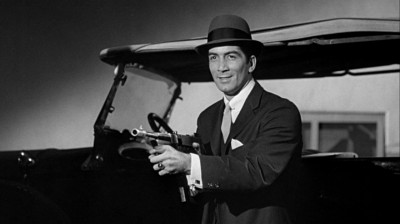
A humorous, ice-cold "B" gangster flick with a knock-out central performance, the 1960 actioner The Rise and Fall of Legs Diamond, helmed by cult director Budd Boetticher and starring Ray Danton in his signature role, is a nasty little homage to earlier Warner Bros. gangster classics, pulling off the neat trick of denying the audience any sympathy for its psychopathic villain―and that usually doesn't happen in these types of movies. Playing around with the genre's conventions, Boetticher gives us a perverse, blackly humorous, violent good time (b>Bonnie and Clyde, anyone?), while memorably denying us the opportunity to find one crumb of redeeming virtue in the title character. Ray Danton is simply brilliant in a criminally neglected performance.
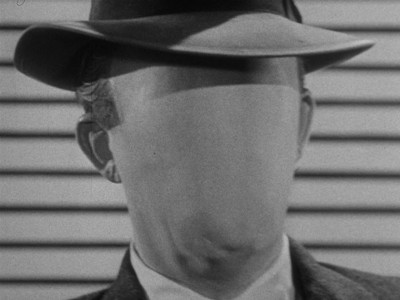
A strange, unsettling film noir mystery with a disturbing subtext, RKO's 1949 thriller, Follow Me Quietly, may come in at an impossibly short 59 minutes...but it packs an unnerving wallop. Directed by Richard Fleischer, with a screenplay based on a story co-written by another celebrated noir alumni, Anthony Mann, dreamy/nightmarish Follow Me Quietly is a brilliant little thriller that's all the more remarkable for its economy of execution and its unsettling subtext that links an obsessed cop and a vicious serial killer a little too closely for comfort.
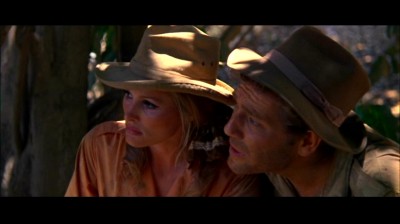
Lazy fun. The Southern Star, the 1969 adventure comedy based on the Jules Verne novel L'Étoile du sud, starring George Segal, Ursula Andress (topless!), Harry Andrews, Ian Hendry, Johnny Sekka, and Orson Welles, is the damnedest, most casual big-budget adventure film you probably never saw. It's difficult to pin down the source of The Southern Star's breezy, sometimes inept approach. But then again...who cares? How many times have you seen this kind of A-list production with such a charmingly nonchalant attitude? The jokes are mostly good, the adventure is hackneyed (and funny for that clichéd familiarity), and the performances are bright (even gorgeous stone-face Andress smiles a couple of times...before getting topless!). What a fun discovery of a little-seen film.
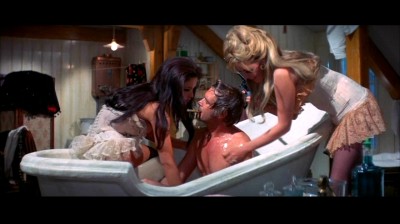
Cannon for Cordoba, the 1970 Mirisch production (for U.A.) starring George Peppard, Giovanna Ralli (I'm feeling faint...), Raf Vallone, Peter Duel, and Don Gordon, is a derivative but solid, action-filled oater. Obviously inspired by better action flicks like The Wild Bunch, The Guns of Navarone, The Dirty Dozen, Where Eagles Dare, and The Professionals, Cannon for Cordoba may not be all that original in story or design, but it moves along at a fast clip thanks to good workmanlike direction from Paul Wendkos, while headliner Peppard is in his usual (and enjoyable) snotty mood. It hits what it aims at: a fast-moving Western action story with some good performances to anchor it.
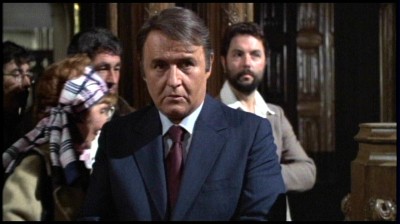
A solid The Day of the Jackal knock-off, Hennessy, the 1975 American International Pictures actioner starring Rod Steiger, Lee Remick, Richard Johnson, Eric Porter and Trevor Howard, kicked up a bit of dust when first released because footage of the British Royal Family was skillfully inserted―without their approval―into the narrative, but today, if it's remembered at all, Hennesy gets a nod for a relatively rare low-key turn by hambone extraordinaire Rod Steiger, and clean direction by Don Sharp. Hennessy's basic framework may be derivative, but it's executed with some efficient verve...even if the final action is a little silly. A grim, layered little revenge drama, given a big boost by Rod Steiger's quiet turn.
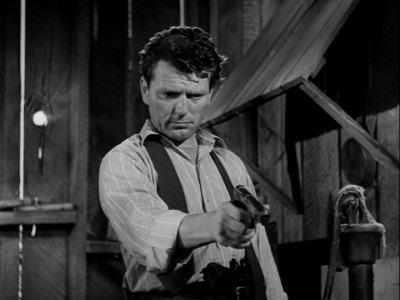
A fast-moving, hard-edged little B-noir from RKO. The Threat, a 1949 thriller starring Michael O'Shea, Virginia Grey, Charles McGraw, Frank Conroy, and Robert Shayne, has a speedy run time of only 65 minutes, telling its revenge story quickly and neatly, with a beautifully psychotic central performance by gravel-voiced McGraw to distinguish it.
Jamie S. Rich reviews The Purple Gang, Three Hours to Kill, and Blind Alley:
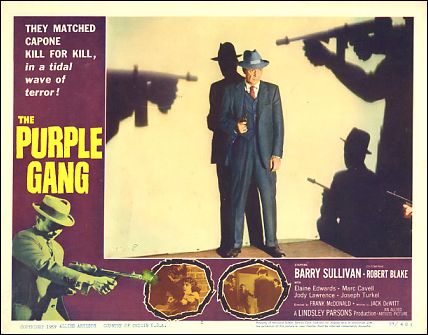
Frank McDonald's 1959 The Purple Gang is an entertaining if underwhelming take on a true story. Documenting the crew of young toughs that terrorized Prohibition-era Detroit and the cop that brought them down, it was part of a wave of anti-crime pictures the Hollywood studios made to show they weren't just about exploitation. Much of the story is by numbers--hotheaded thug takes over the gang, dedicated police detective doesn't rest until he takes him down--but some fine supporting players and the director's facility for artful framing keep it interesting. The Purple Gang is also notable for a young Robert Blake deviously chipping away at his craft as the main gangster. The Purple Gang is lacking in surprises, but dependable.
The 1939 crime thriller Blind Alley is a familiar hostage scenario:
killer on the run traps a group of people in their own home waiting for his way
out. Though this Charles Vidor adaptation of a popular stage play has the added
narrative wrinkle of the homeowner being a Freudian psychologist, the script
never really transcends the very basic plotting. The movie moves at a languid
and predictable pace, though Chester Morris as the troubled bad guy manages to
sizzle in just about every scene. Likewise, Vidor's cinematic portrayals of his
inner turmoil seem inventive even all these years later. Too bad the rest of the
production never quite rises to the same level. A functional old-school
nailbiter, entertaining but somewhat forgettable.

Alfred Werker's 1954 western Three Hours to Kill leaves the fancy stuff for other cowboy movies, but what it lacks in fuss it makes up for in efficient storytelling. Dana Andrews leads the cast as a wronged man returning to town to clear his name and get some payback for the rope scar on his neck. Donna Reed plays his lost love, while Dianne Foster is the hooker with a heart of gold who always knew he didn't murder anybody. (Carolyn Jones also has a brief role as a sexy blonde card dealer). The movie covers the late afternoon hunt that Andrews' character undertakes, seeking out the real killer and exposing the town's dark secrets. It's not great or even super memorable, but Werker takes the material seriously and manages to pull a tight little action picture out of the otherwise very basic plotline.
Moving over to dramas and comedies, Jamie S. Rich looks at Jules Dassin's Phaedra:

Jules Dassin's 1962 retelling of Euripides is a sensuous celebration of all
things Greek. Phaedra stars the director's wife, Melina Mercouri, as the
title character and Anthony Perkins as the stepson with whom she has a dangerous
affair. The story is one of sex and consequences, and Dassin embraces its
central metaphors and stokes their fires using arty photography and breathless
pacing. Theirs is a feverish love affair, and the downfall that follows hits
hard. Phaedra maybe can't maintain the energy it starts out with, but the
performances are strong, the music infectious, and the overall staging is
excellent.
Nick Hartel looks at
Falling prey to "past their prime" reunion syndrome, Hart to Hart Returns fumbles to regain its early 80s stride opening far too many narrative doors that
often are shut ham-handedly at the last minute. Once Robert Wagner and
Stephanie Powers manage to chip away some of the old rust, the magic that made
the original series shines through, despite the main narrative being uninspired
genre drivel. Presented in a manner fitting of its network TV roots, the 1.33:1
original aspect ratio transfer and plain Dolby 2.0 audio track will whisk you
back to the days of the ultra rich and suave using their detective skills for
good, sticking it to greedy industrialists and murderers or quite simply
90-minutes of passable escapist entertainment.
Kurt Dahlke looks at Meet the Stewarts:

Meet the Stewarts, a B-picture comedy from the 1940s, doesn't feel nearly as dated as you'd expect. Despite a leisurely pace and some less-than-politically-correct jokes, universal themes and smart humor make this William Holden/ Frances Dee starrer as good a way to shut off your brain as you'd find with many other smart modern comedies. With a raft of farcical performances still grounded in emotional reality, The Stewarts is a movie―and a married couple―you'll find recommended.
And Paul Mavis looks at
The Hucksters:
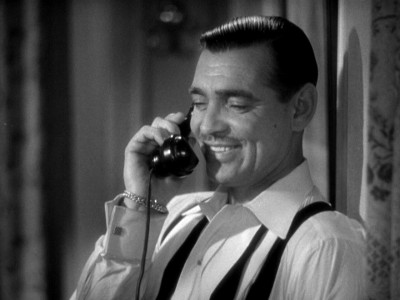
Thoroughly enjoyable, if a tad long, M-G-M glossy, 1947's The Hucksters, the all-star, cleaned-up adaptation of the blockbuster best seller by Frederic Wakeman that took a cynical look at the worlds of radio and advertisement, sees the King of Hollywood, Clark Gable, return to form after a disastrous post-war comeback vehicle, Adventure, in 1945. Ably supported by Deborah Kerr, Sydney Greenstreet, Adolphe Menjou, Ava Gardner, Keenan Wynn, and Edward Arnold, The Hucksters may be necessarily sanitized out of context, and there's certainly too much romancing for the long running time...but Gable is King, and the swipes at the media and advertising worlds are as true today as they were over 70 years ago.


Oh, that's not all. The M.O.D.s never stop, pallie. Upcoming titles include an unstoppable wave of must-have cult titles, including Frank Sinatra's "last" film, Dirty Dingus Magee, Charles Bronson's nasty The Stone Killer, Doris Day's sweet romantic disaster movie Julie, Richard Attenborough's epic biopic, Young Winston, Brian DePalma's Obsession, and James Mason's Cry Terror!.
And we're gonna review 'em all...and more, right here at The M.O.D. Squad! See you next time!
Have a question about MOD discs? Have a suggestion or correction? Drop us an e-mail and we'll try to devote an upcoming column to reader's comments!
Review Staff
| Newsletter Subscribe
| Join DVD Talk Forum
Copyright ©
DVDTalk.com All rights reserved
| Privacy Policy
| Terms of Use
| Manage Preferences
| Your Privacy Choices ![]()
